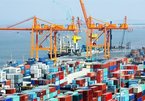 |
|
GSO General Director Nguyen Thi Huong (centre) at a press conference held by the General Statistics Office in Ha Noi on Tuesday.
|
GSO General Director Nguyen Thi Huong said at a press conference in Ha Noi that the GDP growth was dragged down by the deeply-felt impacts of the COVID-19 pandemic.
However, she said, amid the COVID-19 pandemic’s serious impact on every socio-economic aspect of countries around the world, it was still a big success of Viet Nam in the pandemic fight and economic recovery and development.
Huong attributed the positive results to the government’s swift response to the resurgence of the pandemic, by implementing bold measures to contain it. To date all coronavirus outbreaks in localities have been brought under control, and the government has been working towards a dual goal of pandemic prevention and economic recovery.
Between January and September, the agro-forestry-fishery sector increased 1.84 per cent, industry-construction 3.08 per cent, and services 1.37 per cent. They respectively contributed 13.62 per cent, 58.35 per cent, and 28.03 per cent to the overall growth.
The official said in the third quarter alone, GDP rose 2.62 per cent compared to the same period last year, also the slowest Q3 growth pace since 2011.
Thanks to COVID-19 being brought under control, economic activities have gradually resumed in the new normal status, helping the Q3 GDP expand at a faster pace than in Q2 of 0.39 per cent.
Huong said the complex and unpredictable developments of COVID-19 led to growth slowdown in almost all sectors. Disruptions to international trade affected Viet Nam’s production, export and import activities while resulting in high unemployment and job shortages.
Besides, drought and saltwater intrusion that occurred early had affected plant productivity and output.
Facing that fact, the Government and the Prime Minister had issued timely directions for ministries, sectors and localities to carry out concerted and effective solutions so as to concurrently fight against the pandemic, protect people’s health, prevent an economic recession, and maintain social stability, thereby helping to achieve as high as possible results in socio-economic development this year, according to the GSO General Director.
CPI down 0.12 per cent in March
The consumer price index (CPI) in September increased by 0.12 per cent compared to August and 2.98 per cent compared to the same period last year.
In nine months, CPI increased by 3.85 per cent compared to the same period last year and was the highest 9-month rise in the last five years.
Huong attributed the CPI growth in September to the price adjustment of educational services, rising electricity prices due to the increase in electricity demand during summer, as well as rising domestic rice prices due to a 11-year high record export rice prices.
Six of the 11 groups of commodities and services increased, of which beverage and tobacco rose 0.05 per cent, garments, hats and footwear climbed 0.1 per cent, housing and construction materials gained 0.62 per cent, medicine and medical service increased 0.01 per cent, education rose 2.08 per cent, commodities and other services were up 0.02 per cent.
Five groups decreased, including food and catering services, losing 0.31 per cent, household appliance, decreasing by 0.06 per cent, traffic down by 0.12 per cent, post and telecommunications, dropping 0.02 per cent, culture, entertainment and tourism, down 0.2 per cent.
In addition to the reasons for the increase in CPI, there are also some factors that curbed CPI growth in the first nine months, such as petrol prices adjustments and falling travel prices due to the pandemic.
Due to the impact of the COVID-19 pandemic, the travel demand of people decreased, compared to the same period last year, the average air ticket prices in 9 months declined by 33.6 per cent, while train tickets dropped 1.57 per cent. — VNS

The path to economic recovery and further growth
While Vietnam has experienced an unprecedented boom in recent decades, the current pandemic is now having a clear negative impact on the economic outlook.